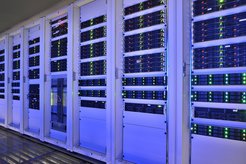New computer cluster at the Max Planck Institute for Gravitational Physics (Albert Einstein Institute) in Potsdam
More computing power to find and interpret gravitational-wave events in the data of the upcoming observation runs
“Our new cluster, Hypatia, is dedicated to data analysis as well as to astrophysical, cosmological and fundamental physics studies of gravitational waves,” says AEI director professor Alessandra Buonanno. “We are looking forward to many new discoveries in the upcoming observing run of the gravitational-wave detectors and Hypatia will be our tool to find and to interpret the signals from merging black holes and neutron stars and whatever else the universe has in store for us.”
Hypatia, the computer cluster's eponym, was an ancient Greek mathematician, astronomer and philosopher who researched and taught in Alexandria in the 4th century after Christ. The Neoplatonist was known as a great teacher in her own lifetime.
Fishing for gravitational waves

Researchers from Buonanno’s division have made important contributions to the discovery and interpretation of the gravitational-wave signals in the first two observing campaigns of the LIGO and Virgo gravitational wave detectors. With Hypatia, the scientists will continue to develop and improve highly accurate models for gravitational-wave signals from binary black holes and neutron stars. These models are essential both to detect the signals and to determine the astrophysical properties of the sources. The scientists will analyze the LIGO and Virgo detector data with Hypatia and will test whether the observations agree with the predictions of Einstein’s equations.
In April, the LIGO and Virgo gravitational wave detectors will commence their third observing campaign with increased sensitivity. This will yield many additional gravitational wave discoveries, perhaps even hitherto unobserved types of gravitational wave sources, like a neutron star being swallowed by a black hole.
The future of gravitational-wave astronomy
The third generation of Earth-based gravitational-wave observatories (Cosmic Explorer and Einstein Telescope) and the planned space-based LISA detector (Laser Interferometer Space Antenna) will probe a wide variety of sources, including compact binaries in the very early universe. With Hypatia, the researchers will quantify the scientific potential of these future observatories, and will develop the high precision models, data-analysis techniques and software tools needed to realize the full discovery potential of these ultrasensitive instruments.
Hypatia’s technical specifications
Hypatia runs on a Linux operating system and has the following features:
- 262 compute nodes (dual-socket, sixteen-core AMD EPYC (Naples) 7351 (2.40 GHz), 14 of which provide 8 GB RAM per core (4 GB per core otherwise)
- two login nodes and one management node
- a 300 TB storage system running BeeGFS.
- two 70 TB file servers based on ZFS
- separate ethernet networks for science-data and system-management
Hypatia provides in total:
- 8384 physical CPU cores
- about 34,500 GB RAM (4 GB per core)
- about 400 TB of disk space












